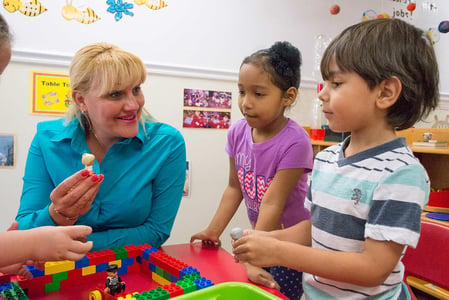
Educators learning about CLASS® are asked to narrate their actions and sportscast their children’s experiences in order to support and encourage healthy language development. Hearing this, many may wonder, “Will people think I’m weird if I start talking to myself in the classroom?”
The answer is no. Self- and parallel talk are beneficial strategies for educators to engage in because they strengthen language rich environments and enhance vocabulary development, all while supporting effective relationship building between teachers and children.
What is self-talk?
In self-talk the educator intentionally describes what he or she is thinking, seeing, hearing, touching or doing. In other words, you're linking words to actions: “I’m giving each of you a handful of animal crackers. I am placing the crackers in a pile in the center of your napkins.” You're saying these words as you actively pass out the snack, making words like, “handful,” “placing,” and “pile” come alive for the children.
Self-talk is NOT simply using “I” statements, such as, “I am going to tour the zoo tomorrow and I will feed a giraffe! I love giraffes.’” Why would statements like this be less effective? In this example, a child may not know know the word “tour” or "giraffe.” These words are said in an abstract way and not made concrete by mapping them to what the child can currently see or experience.
What is parallel-talk?
In parallel talk, the teacher links words directly to children’s current actions or experiences. For example, “You are holding the zipper and zipping your jacket all the way up to your chin.” Educators using parallel talk become a sportscaster, narrating a play-by-play account of what the child is seeing, feeling, or doing, making words personalized and meaningful.
Parallel talk is NOT simply using a “you” statement, such as, “You did a good job painting your picture.” Why? Because this comment refers to something that happened in the past and does not promote the more powerful connection between a child’s real-time experiences and the language that describes these moments in rich, memorable detail.
How can self- and parallel talk be incorporated into your daily schedule?
Take the first step by selecting one part of your daily routine when you can begin to narrate what you and your children are doing during an activity. Try modeling their behavior while describing your actions and pausing for their response, whether it be verbal or non-verbal, and then continuing on with this cycle of communication.
Build relationships! Engage shy, quiet, or non-verbal children by joining them in play and describing both of your actions in a conversational way, focusing on the child’s interests, without adding the stress of asking questions or expecting verbal responses. The child will be exposed to personalized language in a relaxed setting and your relationship will be strengthened by sharing an enjoyable activity together.
Tips to increase the effectiveness of self- and parallel talk
Educators should use these strategies in a back-and-forth, conversational way, being careful not to bombard children with details. While maintaining the flow of communication, frequently pause so that children may join in, either verbally or non-verbally.
The purpose of these strategies is to expose children to meaningful language and enhance language development. To increase effectiveness, there should be no requirement for children to respond to or to imitate what is being said when providing self- and parallel talk.
As you practice mapping actions with words, it will soon become a more natural part of your daily routine and both you and your children will enjoy the benefits of enhanced communication in your classroom.

